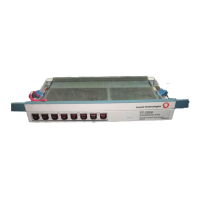Maintenance Description
9-40 Issue 8.0 July 2002
— Selects traffic from a protection tributary on the span towards the
primary node.
NOTE:
This is done by provisioning the 2-Way-DRI-Sec cross-connection at
the secondary node.
When the primary node of the DRIP circuit is isolated, and the other end of the
circuit is visible to the secondary node, the secondary node:
— Bridges traffic on the same protection tributary on the span
away
from the primary node, and
— Selects traffic from the same protection tributary on the span
away
from the primary node.
In effect, the secondary node acts like it is protecting traffic on a
service
tributary
on the span towards the primary node.
Bidirectional 2-fiber ring protection switching is completed within 60 milliseconds
of the onset of a hard failure such as a fiber cut and is compliant with the
applicable Telcordia Technical Advisories and Technical Requirements.
When the signal fail or signal degrade defect clears, the provisionable alarm clear
delay is initiated. Before the defect is declared clear, the OC-48 signal's BER must
be 10 times better than the provisioned signal degrade threshold. For example, if
the provisionable signal degrade threshold is 10
-9
, the OC-48 signal's BER must
fall below 10
-10
to clear the defect.
When the defect is declared clear, the FT-2000 OC-48 Add/Drop-Rings Terminal
enters the provisionable wait-to-restore interval. This prevents any oscillating
between the service and protection STS-3 tributaries. During the wait-to-restore
interval, the service STS-3 tributaries are monitored and should perform better
than the signal degrade threshold.
When the alarm clear delay is reached all indicators are updated. When the
wait-to-restore interval is reached, traffic is revertively switched back to the
service STS-3 tributaries.
Single and Double Failure States 9
Figure 9-9 shows how the FT-2000 OC-48 Add/Drop-Rings Terminal reacts to
single and double failures. Since the probability of double failures in a ring is
significantly less likely than a single failure, and the probability of three failures is
even less likely than a double failure, Figure 9-9 shows how the FT-2000 OC-48
Add/Drop-Rings Terminal reacts to only single and double failures. However,
some of the logic will carry over to highly unlikely multiple failure cases.
In Figure 9-9, the circles represent the states the FT-2000 OC-48 Add/Drop-Rings
Terminal can enter, with respect to 2-fiber ring protection switching. The arrows

